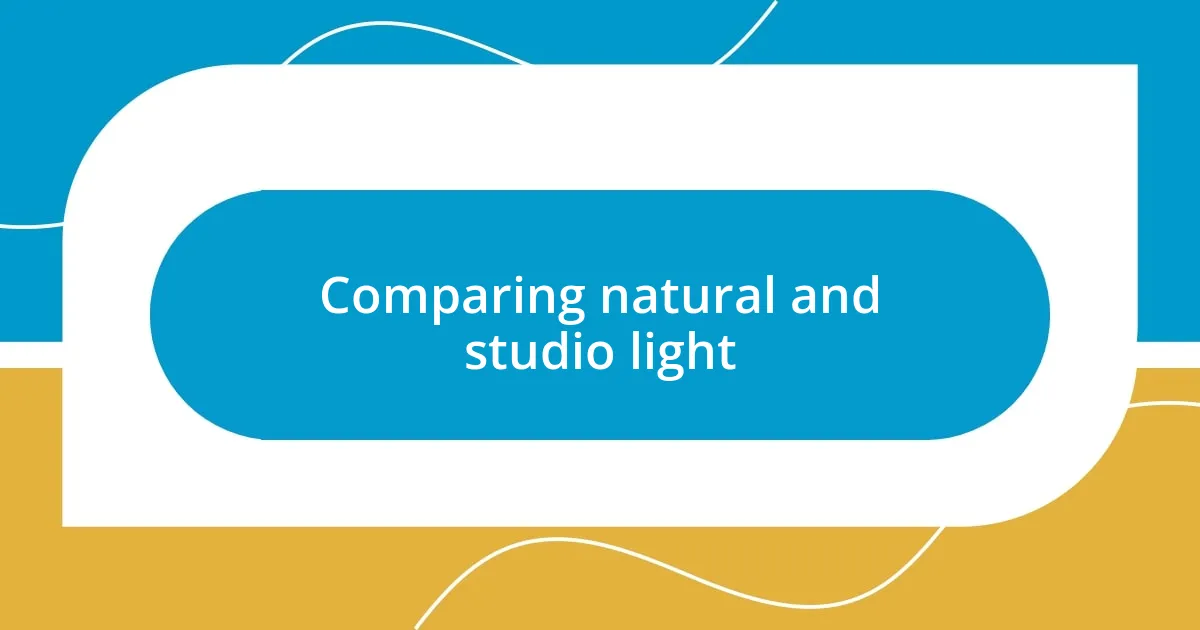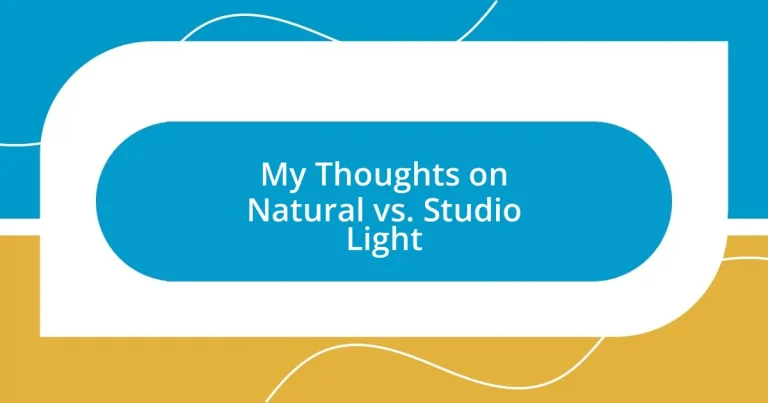Key takeaways:
- Natural light evokes warmth and authenticity, changing moods throughout the day, while studio light offers consistency and control for professional results.
- Techniques for utilizing natural light include tracking its movement and embracing various weather conditions to enhance photographs.
- Studio lighting techniques such as softbox placement, reflectors, and colored gels can dramatically alter the mood and emotion of portraits.
- The choice between natural and studio light reflects the photographer’s artistic vision and emotional intent for the image.

Understanding natural light usage
Natural light brings a unique warmth and authenticity to photographs that studio lighting often struggles to replicate. I remember one early morning when I captured soft sun rays filtering through my kitchen window, casting gentle shadows. That moment transformed an ordinary setting into something magical, making me appreciate the subtle beauty of natural light’s play.
When I think about using natural light, I often reflect on how its quality changes throughout the day. Have you ever noticed how the golden hour can dramatically enhance the mood of a scene? I find myself adjusting my shooting schedule just to capture that fleeting magic. The way light shifts can evoke different emotions — a sunny midday can feel cheerful, while the dusk brings a sense of tranquility.
Understanding the nuances of natural light also involves predicting its behavior in different environments. I’ve spent hours observing how light interacts with various surfaces, like the way it bounces off leaves in a park or how it saturates the walls of a city street. It’s fascinating how these elements can shape the final image, making each session an exciting exploration of possibilities.

Exploring studio light benefits
When it comes to studio light, one of the biggest benefits I’ve discovered is its consistency. I remember a portrait session where, despite the unpredictable weather, I could flawlessly execute my lighting setup. This allowed me to focus on my subject and capture their personality without worrying about sudden changes in lighting conditions. Studio lights provide a controlled environment that helps in achieving repeatable results, making them indispensable for professional photography.
Another aspect I truly appreciate is the versatility of studio lighting setups. I’ve experimented with modifiers like softboxes and umbrellas, and what’s amazing is how each adjustment dramatically alters the atmosphere of a shoot. For instance, when I switched from a hard light to a soft, diffused light, the entire mood shifted from stark to dreamy. It’s like having a multitude of tools at my disposal to paint with light, allowing different levels of creativity that can suit various themes.
The ability to create specific moods and effects in studio lighting leads to endless possibilities for storytelling. Each click of the shutter can evoke a different emotion, all thanks to how I manipulate the artificial light around my subject. Last year, I worked on a project featuring dramatic lighting contrasts for a fashion shoot, and the results were breathtaking. It reinforced my belief that, while natural light has its charm, the precision of studio lighting can turn a concept into a striking visual narrative.
| Studio Light Benefit | Description |
|---|---|
| Consistency | Provides reliable lighting regardless of external conditions. |
| Versatility | Allows the use of different modifiers to create varied effects. |
| Mood Creation | Enables specific emotional storytelling through precise light manipulation. |

Comparing natural and studio light
When I compare natural and studio light, I can’t help but think about the different emotions they evoke. I once photographed a couple in a sun-drenched park, and the golden light created an intimate, warm ambiance that enhanced their connection. Conversely, during a nighttime studio shoot, I experimented with colored gels, transforming the mood to one of vibrant energy and excitement. Each type of light presents its own charm, fulfilling distinct artistic visions.
Here’s a quick rundown of some key differences between natural and studio light:
- Mood and Emotion: Natural light often feels soft and organic, fostering a sense of warmth, while studio light can be bold and dynamic, perfect for dramatic results.
- Control: Studio lighting gives me complete control over the intensity and direction, whereas natural light can be unpredictable and requires constant adjustment.
- Color Temperature: With natural light, I appreciate the subtle shifts in color throughout the day, while studio lighting allows me to select precise color temperatures to achieve the desired mood.

Techniques for using natural light
One technique I’ve found invaluable for working with natural light is to track its movement throughout the day. For instance, during a mid-morning picnic shoot, I noticed how the light poured in gently from the east, casting soft, flattering shadows that added depth to my subjects. This approach teaches me to be patient and adapt my shooting times for the best light, often leading to unexpectedly beautiful results that can genuinely elevate a photograph.
When I photograph in natural light, I also make an effort to reflect on the weather conditions. I clearly remember a day when the skies were overcast—a situation many dread. Instead of packing up, I seized the opportunity to capture portraits with beautiful, diffused lighting that softened features and eliminated harsh shadows. I realized that embracing these less-than-ideal scenarios allows me to create striking images, often with an emotive quality that resonates deeply with viewers.
Positioning my subjects in relation to natural light is crucial as well. I often explore different angles; for instance, during a sunset shoot, I had a couple stand with the sun behind them, creating a stunning halo effect. This technique not only highlighted their silhouettes but also added a dreamy, romantic touch to the scene. It’s amazing how adjusting the angle, even slightly, can transform a mundane snapshot into a breathtaking moment filled with emotion.

Techniques for using studio light
When using studio light, I always start by controlling the softbox placement to manipulate shadows and highlights effectively. I remember one shoot where I placed the softbox slightly above and to the side of my model. The result was a beautiful, flattering light that sculpted their features, creating a more dramatic and engaging portrait. Isn’t it interesting how a small shift can make such a significant impact?
Another technique I’ve mastered is the use of reflectors to bounce light back toward the subject. I once worked with a client who had deep-set eyes, and I positioned a gold reflector just out of the camera frame. The warm glow that bounced back softened the shadows and brought a lovely shimmer to their eyes, adding an unexpected sparkle to the image. I often wonder—how many photographers overlook something so simple yet powerful?
Finally, experimenting with colored gels has been a game-changer for me. On one memorable occasion, I transformed an otherwise plain backdrop by adding a blue gel to one light and a pink gel to another. The mixture created a captivating contrast that elevated the entire composition. It’s a fun way to play with emotions in portraits, and it really makes you think about how color can shape a viewer’s experience. Why not dive into this creative avenue during your next studio session?

Final thoughts on light selection
Choosing the right light can make or break a photograph, and I’ve often pondered how it reflects my artistic vision. I recall a time when I was torn between natural light and studio settings for a family shoot. Ultimately, I opted for natural light, allowing the evening sun to infuse warmth and authenticity into their expressions. That decision didn’t just add a glow to the image; it captured their joy in a way that felt true and relatable.
Still, there are moments when I crave the control that studio light provides. During a recent fashion shoot, I deliberately set a high-key lighting scheme to create a vibrant ambiance. It was thrilling to see how the subject’s energy transformed with careful light selection. How amazing is it that subtle changes in light can evoke entirely different moods and stories in a single frame?
In my experience, the decision between natural and studio light ultimately reflects my emotional intent behind the image. I remember grappling with that choice while shooting landscapes versus portraits; the former thrives under nature’s ever-changing palette, while the latter often benefits from the precise manipulation available in a controlled environment. Isn’t it fascinating how the journey of light selection can shape both the visual appeal and the emotional resonance of our work?












